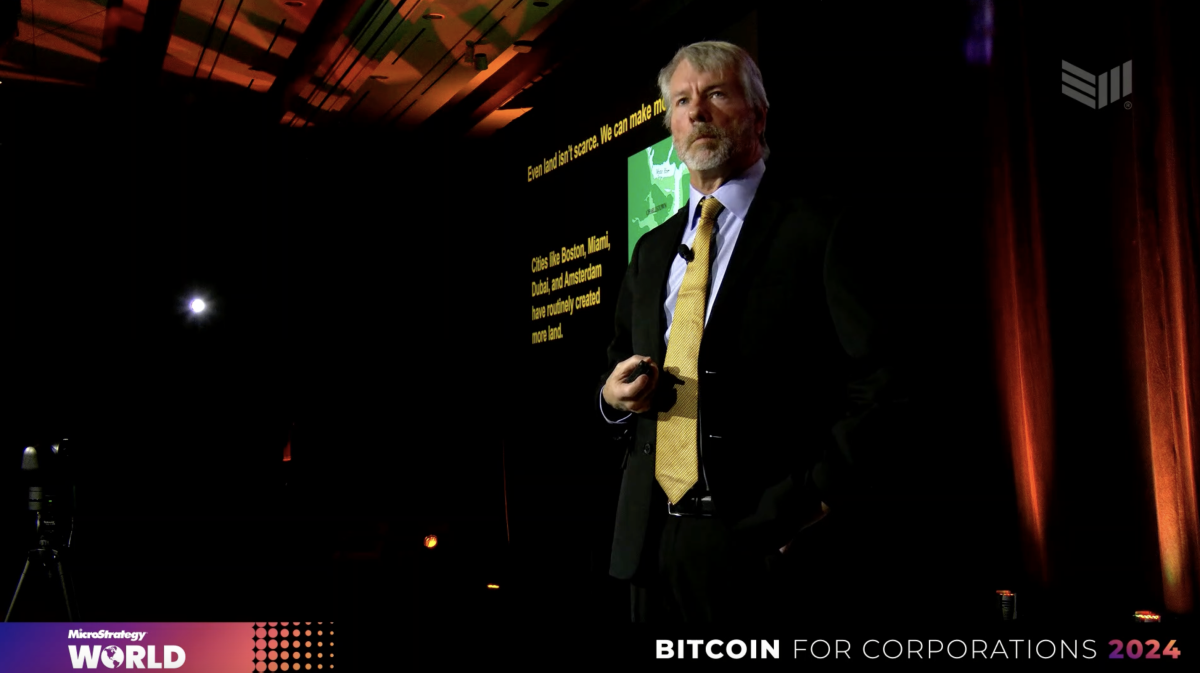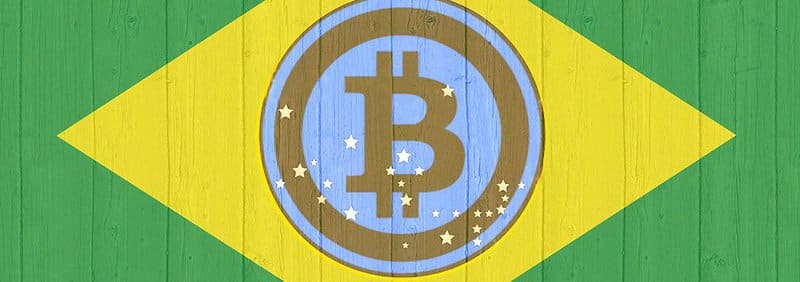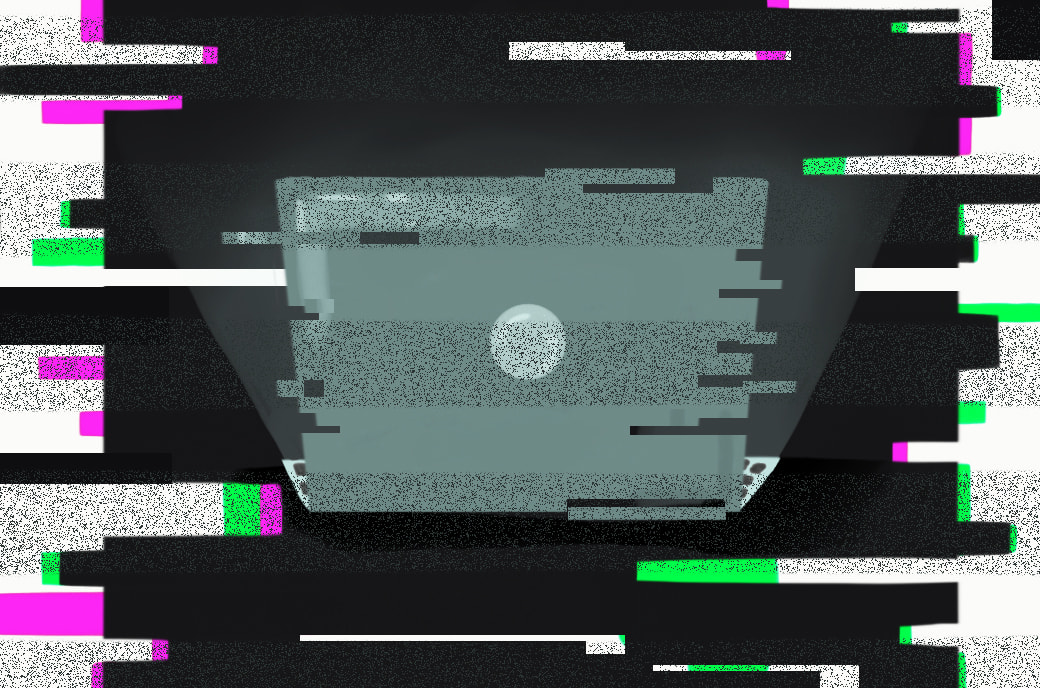Inside Immersion Cooling: The Pros And Cons Of Bitcoin Mining’s Rapidly-Growing Practice
Immersion cooling has emerged as a rapidly-evolving technique for increasing bitcoin mining rig efficiency, with many pros, cons and details to consider.
Scott’s Mining Conference, hosted in Round Rock, Texas on February 7 and 8, featured a panel entitled “Immersion” with five panelists: David Branscum (director of business development at Midas Immersion Cooling), Justin Podhola (founder and CEO of Elite Mining Inc.), Scot Johnson (CEO of Digital Shovel), Jonathan Yuan (owner of Coin Heated LLC) and Gary Testa (president and CEO of Engineered Fluids); and it was moderated by Tone Vays (host of Unconfiscatible Conference and avid Bitcoiner).
The panelists universally agreed that immersion cooling is the future of Bitcoin mining, and the following is a summary of said panel with a light introduction to mining for the uninitiated.
Bitcoin Mining At A Glance
Mining on the Bitcoin network is the process of both adding transactions to the open ledger, known as the blockchain, and securing the history of those transactions in such a way that modifying that ledger by any one entity is computationally, energetically and financially impractical.
Bitcoin mining is primarily done with an ASIC (application-specific integrated circuit), colloquially known as a “mining rig” for a single computer system, which seeks to solve a computationally-difficult problem that the network will accept. Bitcoin miners compete with one another to mine the next block in the blockchain and the protocol rewards the block subsidy to the successful miner, currently 6.25 bitcoin (this concept is expanded upon in the “Additional Information” section below) , as well as any network transaction fees included in that block.
The process of calculating a SHA-256 hash to be accepted by the network, the computationally-difficult problem miners are attempting to solve, is intentionally resource intensive.
While this process works to limit the number of blocks found each day, it also forces miners to “prove” their computational work was fairly and correctly done according to the rules of the protocol before blocks are added to the ledger — known altogether as proof of work. Miners securing the Bitcoin network using ASICs through proof of work allow the fair and random dissemination of new coins in a decentralized manner, unlike other protocol-securing methods such as proof of stake, which specifically work to reward the wealthiest members of the network. In Bitcoin’s protocol, whales — large bitcoin holders — do not receive rewards nor serve to protect the network simply by virtue of their bitcoin accumulation.
While this explanation of Bitcoin mining is severely abridged, the core concept is laid out and we can begin examining air-cooled and immersion-cooled mining systems.
Note: The term “ASIC” and “mining rig” are used interchangeably below. The panelists only discussed the installation and benefits of “single-phase” immersion cooling.
Air Versus Immersion Cooling For Bitcoin Miners
Generally speaking, mining rigs are designed with high-velocity fans forcing air flow across the ASIC’s internal components to actively cool the hashboards — the computer chips that are hashing day and night to solve the aforementioned computationally-difficult problem.
The energy expended per hash calculation can be made more efficient and reduce overall operational costs for the miner if the setup can effectively whisk away heat generated by the hashboards. The overarching goal in cooling mining rigs is to provide the most cooling with the least possible cost. “Air-cooled” Bitcoin mining is the traditional and simple method of managing the heating and cooling of one’s mining rigs with ventilation fans and ordinary, atmospheric air.
“Immersion-cooled” Bitcoin mining also works to manage the heating and cooling of mining rigs, but with circulation pumps and special liquids designed to work with electronics in lieu of air.
Below are pictorial examples of air-cooled and immersion-cooled systems:
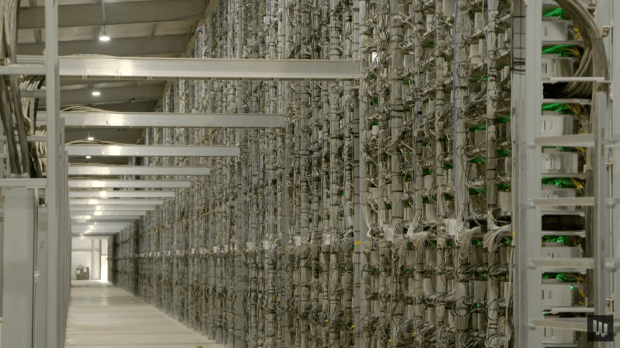
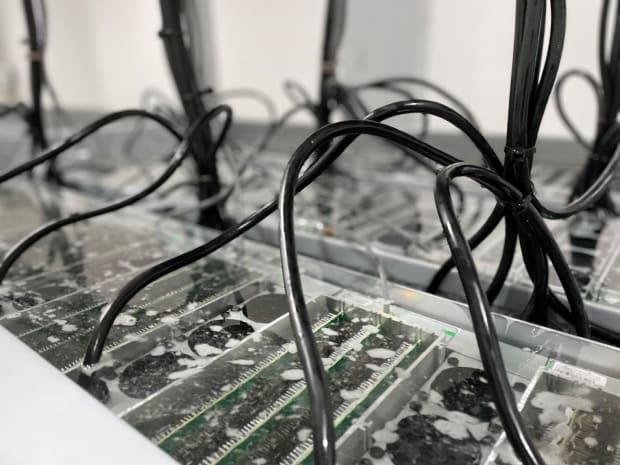
Immersion is the practice of completely submerging, or immersing, the mining rig in a thermally-conductive liquid with greater insulating properties than ordinary air. Perhaps counterintuitive at first, dunking your energized electronic mining rig into a specially-designed liquid allows for greater heat removal from the always hot and hashing computer chips.
The ASIC can hash more efficiently if given constant, optimal temperatures and continue to mine bitcoin longer with the aid of specially-designed, heat-removing liquids. Imagine after going on a jog, you need to cool down — it would be quicker and more effective to immerse yourself in a cool pool of water than to just stand outside for the air to gradually cool you down.
The same thought process can be applied to the ASIC computer chips needing to cool down. Liquid has greater heat transfer capacity than air, making for an ideal cooling medium. Miners are primarily concerned with achieving an optimal flow rate of the air or dielectric liquid over the hashboards. The cooling medium travels over the heat-dissipating heatsinks on the individual chips and transfers thermal energy from the hotter surface (the chip’s heatsink) to the cooler substance (the air or liquid) — thus maintaining the necessary temperatures for sustaining proper chip operation. Liquids are far more effective at conveying heat away from the heat source versus air on the scale of 1,200-times or greater performance.
As with any electronic over time, the ASIC eventually succumbs to its constant hashing duress and fails, appropriately referred to as the “death rate” or “failure rate” of the mining rigs. Symptoms of high, prolonged operation temperatures that result in permanent chip damage include thermal runaway via increased leakage currents, higher quantization error rate due to decreasing signal-to-noise ratio, irreversibly overheating transistors and additional loss of transistor control. Decreasing the death rate of one’s rigs through heating and cooling optimizations will in turn squeak out additional profits. This is where immersion cooling can help reduce the death rate to capitalize on mining rig longevity and return savings back to the miner’s budget.
The name of the mining game is effectively scaling operations with minimal additional costs, such that the skill of scaling a Bitcoin mining operation is a form of art, expressed in the medium of cutthroat expenses.
The Advantages Of Immersion Cooling
As mentioned, immersion cooling can reduce the death rate of one’s mining rigs. Immersion cooling also allows for easier overclocking of the ASIC, a practice that involves increasing the terahashes per second (TH/s) of the mining rig, but will similarly increase power consumption and heat generation.
Without a means to properly mitigate the additional heat load, the ASIC may become unreliable or fail entirely. For example, a preconfigured ASIC specified for 100 TH/s at 3,000 watts could be overclocked to 140 TH/s but at 5,000 watts, meaning your total hash rate per ASIC has increased, but your energy expended per terahash per second has also increased. Fine tuning the overclocking mechanism can result in optimum hashing power efficiency.
By increasing the hashing power per ASIC while sacrificing additional power expenditure, money can actually be saved in reducing your total mining rig footprint. For instance, 1 megawatt of power can serve 333 air-cooled mining rigs at the preconfigured 3,000 watts each whereas, through immersion-cooled overclocking, that 1 megawatt of power can serve 200 or 250 mining rigs at 4,000 or 5, 000 watts each, generating cost savings by demanding fewer mining rigs per megawatt. Furthermore, reducing the quantity of miners also shrinks facility size requirements and reduces onsite personnel needs. Increasing hashing power allows for greater opportunity to earn more bitcoin and therefore continue scaling operations.
Another advantage to immersion-cooled mining is the elimination of air particulate build-up on the mining chips, which degrades mining rig performance over time if not regularly cleaned. As particulate builds up on the chip surface, the chip is increasingly unable to efficiently radiate heat and sustain operation. These air particulates are typically filtered out to a certain extent in air-cooled systems, but not filtered out entirely. Air filters can only eliminate particulate to a certain size based on the filter rating, and higher filter ratings induce greater pressure drops across said filters, potentially starving the ASIC of the necessary airflow for successful operation without also upping the intake or exhaust fan motors, and consequently, electrical costs for the increased motors. Immersion-cooled mining is a semi-closed process that keeps ASICs nice, clean and generally safer, whereas air-cooled mining takes whatever resides in the air and passes it through the ASIC, such as dust particulate, pollen and smog residue.
An additional benefit of eliminating particulate buildup through immersion cooling can be setting up shop in geographic settings with low-quality atmospheric air that would otherwise deteriorate the computer chips quicker than normal in an air-cooled setup. Locales with extreme climates but promising energy sources are made potentially viable with the implementation of immersion-cooled mining where air-cooled mining may be unreasonable due to poor atmospheric conditions. Immersion cooling can continue to push the boundaries of mining into remote regions that would have previously been unfavorable for air-cooled systems.
A sometimes overlooked aspect in mining is the sheer noise generated by a single ASIC, typically in the realm of 70 to 80 decibels (dB), or similar to the sound of a vacuum cleaner… 24 hours a day, seven days a week, all year round. Air-cooled mining rigs can be enclosed with sound attenuating material to reduce the noise by around 10 to 20 dB, if done well. However, immersion cooling practically eliminates the unbearable operating noise of ASICs to an undetectable background noise. This can be an especially useful advantage if mining at home with roommates or a significant other and noise propagation is of concern.
Additionally, immersion cooling is a greener approach to Bitcoin mining since the heat rejection from the ASICs can be totally recaptured and repurposed for heating your domestic water, swimming pool and underfloor radiant heating as a few examples. A number of companies already capitalize on this heat rejection through the form of complementing primary heating systems, such as Wise Mining, Hotmine and Ming Energy (the author cannot verify the quality or validity of the companies and products mentioned).
While it is certainly not necessary to integrate Bitcoin mining with these extracurricular systems, the wasted heat from the mining rigs can indeed be harnessed to reduce expenses spent on home heating systems — and one might as well earn some money back on the energy expended toward home heating.
Although not explicitly discussed at the panel, the implementation of immersion cooling implies reduced e-waste due to a reduced mining rig failure rate. Based on a generally unfounded concern, minimizing e-waste is directly correlated with increased savings for the miner. As previously mentioned, cutting costs and negating unnecessary expenses is crucial in scaling operations and growing profits. Concern that the earth’s landfills will overflow with mining rig e-waste would be in direct violation of the goals that those very same miners seek to achieve: squeezing and stretching every last satoshi spent on maintaining operation uptime.
To recap, immersion-cooling eliminates corrosive air particulate buildup and, when correctly overclocked, can even extend the mining rig operating lifetime as well as pump out extra terahashes per second — effectively saving money on the quantity of rigs required to achieve an equivalent hash rate of air-cooled mining rigs. If one desires, the heat waste could also be repurposed for returning additional savings to the miner’s pockets in the form of decreased utility bills.
Of course, there are also “downsides” to working with immersion cooling that need to be thoroughly considered before deciding which cooling system is best for your setup.
Disadvantages Of Immersion Cooling
While not thoroughly discussed by the panelists, maybe even glossed over, there are disadvantages in immersion cooling that may intimidate or simply frustrate new miners looking to get into the industry.
Historically, the cost of setting up immersion mining rigs was economically prohibitive but has become more lucrative than was the case five or six years ago. Still though, the up-front capital required poses a challenge to those looking to dip their toes into immersion-cooled mining. The other perspective to this, though, is that components like the dielectric fluid may be expensive but can be seen as a form of “insurance” to ensure the mining rig operates to its maximum potential lifetime expectancy.
Modifying hardware for immersion cooling requires understanding both the liquid being used and the mining rigs being used, as some liquids may work better with some rigs than other liquids, and vice versa. In practice, the design will depend on the application. It is also prudent to ensure not only that the liquid is compatible with the proposed hardware, but also that the firmware running that hardware is suitable. Without first researching the compatibility of the liquid, firmware and hardware, the ASIC may fail to operate once submerged. While not technically a disadvantage, this research and development step can put off miners simply wanting to plug in the mining rig and call it a day.
Sizing, selecting and designing the immersion-cooled system components such as the piping, tanks and pumps require additional research and set-up time. The cooling medium must be recirculated between the tank and the heat exchanger at a precise rate, otherwise the mining rig may overheat. If liquid flow is too slow, then heat will not be adequately removed from the chip heatsinks and if liquid flow is too fast, then chip-to-liquid heat exchange will not occur appropriately and the ASIC overheats. Not to mention, if the tank, pump and interconnected piping system are not sealed in an airtight manner, then expensive dielectric liquid will leak and potentially negate hashing efficiency gains.
Air-cooled setups similarly need engineering forethought in sizing, selecting and designing ventilation systems and any sound-reducing enclosures, but immersion cooling is relatively more complex in its execution for the rookie Bitcoin miner.
At some point, repairing, maintaining or simply moving the ASIC will be necessary. Due to the oily characteristics of the non-conductive fluid used in immersion cooling applications, cleaning the substance off the equipment prior to maintenance would be required — a rather messy step in general that is avoided with air-cooled mining rigs. This is perhaps more akin to a “pick your poison” scenario between cleaning off annoying oil in immersion cooling setups or cleaning off corrosive, fine particulate in air cooling setups.
Closing Thoughts
In summary, air-cooled mining rigs are quick and easy to get started but come with tradeoffs that must be reviewed by anyone seriously looking to get into mining. The panelists strongly encouraged anyone who is able to support the mining rig’s installation recommendations to give home mining a try. If not mining for the sake of scaling, try mining for a deeper, hands-on knowledge of the Bitcoin network behind the scenes while stacking non-KYC bitcoin at a premium.
Air-cooled Bitcoin mining may not be sufficient for the ever-evolving, energy-demanding computers, some panelists hypothesized. The increasingly advanced chip design may ultimately require immersion cooling if air can’t feasibly handle the rig’s heat load. As single Bitcoin mining rigs and entire mining operations continue to push the limits of hashing efficiencies, immersion cooling may become the most meaningful method for miners to grow their total hash rates and reduce overall expenses. Additionally, as hardware costs increase, the value proposition of immersion cooling becomes more attractive by maximizing mining rig lifetime, which would essentially remain true forever.
If you’re dabbling in Bitcoin mining, then joining relevant events, chat groups and local meetups are vital tools in learning tips and tricks of the industry. Rome wasn’t built in a day, and virtually all large-scale Bitcoin miners today once started from zero as well. Socializing and networking with fellow miners can also form potential business partners, such as the land owner with cheap electricity but lacking capital, or the experienced miner with rigs at the ready in need of cheap electricity and physical infrastructure, or the venture capitalist with the financial know-how but lack of technical orientation. These meetups are about finding the yin to your yang, the missing piece to your Bitcoin mining puzzle.
A final note for new miners uncertain of Bitcoin mining as a viable profession: Whinstone CEO Chad Everett Harris had some positive advice for miners intrigued in beginning their own mining operation as he welcomed our tour group at the Whinstone mining facility in Rockdale. Anyone can do it.
Whinstone formed from a discussion at Chipotle over some burritos only four years ago, according to Harris, where he and three others (Jason Les, Ashton Harris and David Schatz) focused their entire attention toward Bitcoin mining, despite none of them having prior experience with large-scale mining operations. It was a journey and a learning process — Harris credits their success to intertwining their expansive operations with the local community, embracing the population and becoming involved with bettering the living standards of both their employees and the community of Rockdale.
Additional Information
The block reward is currently 6.25 bitcoin and will be reduced by 50% every 210,000 blocks. Each block is added to the ledger every 10 minutes on average, equating to about four years for the block reward to be slashed. This is the infamous 21,000,000 bitcoin controlled supply cap that limits the total number of bitcoin to ever circulate. It is estimated that by the year 2140, all bitcoin will be mined and the block reward will only consist of transaction fees that will, in theory, be sufficient enough to pay the miners for their work in securing the network.
This is a guest post by Okada. Opinions expressed are entirely their own and do not necessarily reflect those of BTC, Inc. or Bitcoin Magazine.

